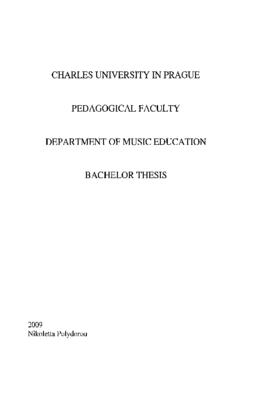Hudba ve střední Africe
Central African Music
bakalářská práce (OBHÁJENO)

Zobrazit/
Trvalý odkaz
http://hdl.handle.net/20.500.11956/28918Identifikátory
SIS: 73440
Kolekce
- Kvalifikační práce [19087]
Autor
Vedoucí práce
Oponent práce
Pecháček, Stanislav
Fakulta / součást
Pedagogická fakulta
Obor
Hudební výchova se zaměřením na vzdělávání - Sbormistrovství se zaměřením na vzdělávání
Katedra / ústav / klinika
Katedra hudební výchovy
Datum obhajoby
1. 6. 2009
Nakladatel
Univerzita Karlova, Pedagogická fakultaJazyk
Čeština
Známka
Velmi dobře
Ve své bakalářské práci jsem zkoumala jak může být použita harmonie, rytmus a formy v ceremoniální hudbě Střední Afriky, ty formy a rytmy, které můžeme nalézt také v evropské hudbě, ale poněkud odlišné. Nejdříve jsem popisovala geografické oblasti Střední Afriky a jejich rozdělení v zeměpisné šířce. Jak jsou v těchto svobodných územích od doby vyznačení hranic zahrnuta politická teritoria. Tato teritoria představují Francouzskou rovníkovou Afriku, Belgické Kongo a Ruanda-Urundi, Ugandu a Tanganyiku. Dále se zabývám obřadní hudbou a tím, jak se v ní spojily hudba, tanec a divadlo.Je zvláštní zjistit, že v některých jazycích je užito pouze jedno slovo pro hudbu, tanec a divadlo. Zkoumala jsem obřady léčení, zasvěcení, narození, svatby, honu, Nového roku a nového měsíce. Nicméně jedna z nejzajímavějších částí mé práce pojednává o mluvícím bubnu, tj. bubnu, který je schopen promluvit, aby oznámil významné zprávy příslušníkům kmenů. Připadá mi to velmi unikátní, ale přitom je to normální, zvážíme-li, že některé z těchto kmenů mají dosud devět výškových hladin své řeči. Další zvláštní prvek je rytmus. Styl africké hemioly známe z rané evropské hudby. Co se týče harmonie, nej zajímavější je hoquetus, technika, která může být popsána jako lomení melodického proudu do přerušovaných fragmentů mezi dva či více hlasů....
In my bachelor thesis I studied how harmony, rhythm and forms can apply in ceremonial music in Central Africa, forms and rhythms that we can find in European music also but somehow different. Firstly, I spoke about the Geographical area in Central Africa, which is divided in latitudes. And how in these latitudes since there were boundary marks, political territories involved. These territories were French Equatorial Africa, the Belgian Congo and Ruanda - Urundi, Uganda and Tanganyika. Secondly, I speak about ceremonial music, how music, dance and drama come together. It is very strange to notice that in some of their languages they use only one word for music, dance and drama. I moved through healing, initiation, birth, marriage, hunting, and New Year and new moon ceremonies. Furthermore, one of the most interesting parts of my thesis is the "Talking Drum", a drum that can announce important news to the tribes. For me of course is very unique but it is normal if we consider that some of these tribes have until nine pitch levels in their speech. One of their special elements is rhythm. African hemiola style is a style that we know from early European music. Considering harmony the most interesting is "hocketus", a technique that can be described by breaking up the melodic flow into interrupted (hiccupped)...
